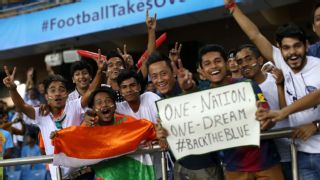|
When India won the right to host the 2020 U-17 Women's World Cup on Friday, this writer's thoughts immediately went to two young women he has read about or known. The first, Nathania John, is someone ESPN's Sharda Ugra recently wrote about. The other was a precocious 12-year-old that was playing in a Delhi girls' league game in 2004, whose game had skill, confidence and speed way beyond her years. *** 'Can help develop women's football' Juhi Shah is player-manager of Bodyline FC, a Mumbai-based club that participates each season in the Indian Women's League (IWL) that the All India Football Federation (AIFF) launched in 2016. It came close on the heels of AIFF forming a department dedicated to women's football in 2015. "In terms of getting a women's World Cup to India, amazing. In a way, this has come at a good time, because it helps you develop women's football," Juhi tells ESPN. "I feel it's also a little too soon, because it is very difficult to get a team up within a year and a half and ready for a World Cup."
Also read: A shame I am not young enough to play in the WC: Bembem Devi Wish I was older: Nathania John, 12, on U17 Women's World Cup What hosting the U-17 Women's World Cup could mean for India
It's a sentiment that Manasi Pathak, a journalism student who has covered football, shares. "Even with the men's U-17 team, the Indians were not as technically sound as the players from other countries. A similar thing is likely to happen here as well," says Manasi. "When you don't have a proper domestic structure in place for the senior players, how can you host the U-17 World Cup? Now again there will be all kinds of exposure trips and other means to prepare a team. Why not just put that money into grassroots development?" Former India captain and recently appointed NEROCA coach Renedy Singh, too, is excited about a home World Cup, but cautions against expecting too much from the event. "The best thing about a World Cup is that the infrastructure gets improved," he says. "All said and done, we are moving in the right direction in men's football, even if the progress is slow. With women's football, we have to be a lot more organised than what we are." 'Who will be India's coach?' Women's football features prominently, as high as fourth out of seven points, in the AIFF's strategic plan for 2019-2022. The broad aims are four-fold -- to grade the AIFF's Baby Leagues on the basis of participation by girls, to start youth leagues (U-13, U-15 and U-18) for girls at district level, strengthening state leagues, and to expand the IWL to 25 states and union territories from the existing 11 by 2022. There is also a plan to start an U-14 national academy, but importantly a lot of these look ahead, and the 2020 World Cup is 21 months away, at the farthest. It's a concern for Juhi, who believes that with India already having bid for the World Cup, there needed to have been a comprehensive scouting plan for the players in place. "We got the World Cup on Friday. We now need posters saying we are planning scouting camps on such-and-such date. I don't see that happening yet," she says, emphasising on how India's first round exit in the AFC qualifiers in September meant they wouldn't have qualified for the World Cup apart from as hosts. "We have talent, but it needs finding. The second question would be who will be the coach? Personally I would want someone from abroad or someone with experience." "It has to happen now, and when I say now, I mean five minutes back, and not five minutes later!" 'No structure, no organisation'  Renedy acknowledges how lucky he was compared to women like Bembem Devi or Bala Devi, who have all made a career in football coming from the north-eastern state of Manipur. "I left home at 11. I got selected to Tata Football Academy (TFA) when I was in class five," he says. "For them, there was no proper organisation. They have played for so many years and at such a high level, and that is a credit to them. Not to the organisation." In Manasi's interactions with women footballers, such as national team member Dalima Chhibber, the two common themes mentioned were the inability to look at football as a profession, and the lack of exposure against quality opposition at the international level. Juhi speaks about how a girl growing up in Mumbai can only play up to school and college, but then finds the pathways dry up to pursue a career further. "Once you are in university, you are done. You are in a job and you are busy working. There is no structure," she says. "I feel with IWL coming up, it can't be running for just a month where players come in, they play six games in a span of two and a half weeks. It's a lot of pressure to put on a youngster's body." "IWL needs to be over a longer time-frame. It is too short a span to develop a player, or to have a structure in place." '...But huge potential' Manasi agrees, though, that having a Women's World Cup is a great opportunity to shine the spotlight on the women's game in India. "If the girls do well, then people will start taking interest in women's football in general. Taking interest in junior teams takes a lot more effort than following the senior teams," she says. "There's no visibility -- a lot of us can't even name the first eleven. Maybe the senior women will also benefit. I don't even know if women's football has ever been shown." Renedy believes there's talent, but it just needs proper scouting. "There are many [Manipuri] players in the women's team, but the organisation is zero. Honestly, organisation in Mizoram, Meghalaya, Nagaland and even Arunachal Pradesh has become way better," he says. "Association-wise, we are far behind, but potential and interest are both huge. We will have the biggest number." *** The young girl from Delhi now studies business management abroad and probably gets just about enough time for an occasional kick-about. The odds on a big Indian performance may not look bright, but what happens once the final is over would determine the course that women's football takes in India. And no matter what happens, hopefully this World Cup will mean Nathania and her ilk will not necessarily have to drop out of the game in future years.
|

